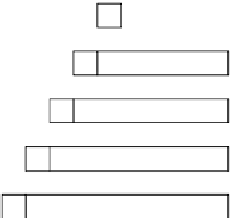Image Processing Reference
In-Depth Information
Transmit process
Receive process
Data
Application
layer
Presentation
layer
Session
layer
Transport
layer
Network
layer
Data link
layer
Physical
layer
Application
layer
Presentation
layer
Session
layer
Transport
layer
Network
layer
Data link
layer
Physical
layer
Application protocol
A- P D U
Message
AH
Data
Presentation protocol
P-PDU
PH
Data
Session protocol
S-PDU
SH
Data
Transport protocol
T-PDU
Telegram
TH
Data
Network protocol
N-PDU
Packet
NH
Data
Data link protocol
L-PDU
Frame
LH
Data
LT
Bit transmission protocol
Bits
FIGURE .
Layer structure of the OSI model and data frame formation.
worked out for the layers. These standards are not part of the reference model and were later
published in their own right.
20.4.1 Layer Structure
The clear distinction between horizontal and vertical communication was the key to the definition
of interconnectable systems. Figure . shows the layer structure and how the data are passed from
one process to another. A system application initiates a transmission via layer of its communication
stack. To fulfill this task, layer prepares data for its peer layer on the receiving side, packages this
and requests services of layer to transmit this data. Layer does the same. It prepares data for the
peer layer
′
to fulfill its task and requests services from the next lower layer , and so on all the way
down to layer , which actually transmits the data. On the way down the layers, the data of the appli-
cation process are augmented by layer-specific data needed to execute the respective protocols. hese
data are typically address and control information that is mostly combined in a protocol header. In
addition, the data may be segmented into individual packets to match the allowed maximum packet
size for a given layer. This way, the number of bits being actually transmitted can be significantly
larger than the pure user data provided by the application process, and the communication over-
head can be substantial. On the receiving side, the peer layers strip all this additional information
to recover the user data for the application process. he basic functions of the individual layers are
briefly described below.
Layer(PhysicalLayer)
As the name suggests, this layer describes all mechanical, physical, optical, electrical, and logi-
cal properties of the communication system. This includes, e.g., definition of the connector type,
impedances, transmission frequencies, admissible line lengths, line types, the type of coding of indi-
vidual bits (such as NRZI: Non-Return to Zero Inverted, RZ: Return to Zero, Manchester Coding),
simultaneous transmission of energy and data, signal energy imitations for intrinsically safe appli-
cations, and the like. One of the most widely used standards for layer in fieldbus technology is the

























































